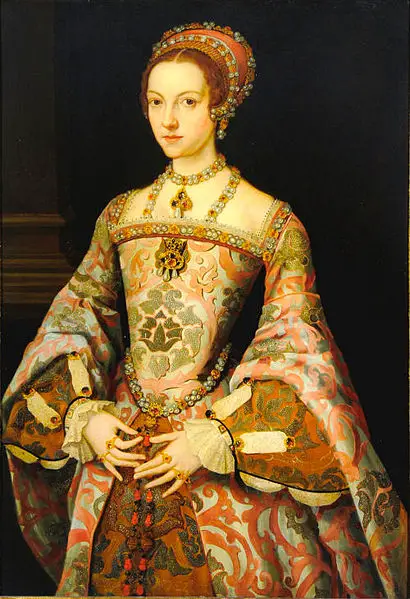 Thank you to Tudor Life magazine contributor Kyra Kramer for this excellent article on Sir Henry Norris, Henry VIII's Groom of the Stool, and the fall of Anne Boleyn. Over to Kyra...
Thank you to Tudor Life magazine contributor Kyra Kramer for this excellent article on Sir Henry Norris, Henry VIII's Groom of the Stool, and the fall of Anne Boleyn. Over to Kyra...
Of all the men who were falsely accused of being Anne Boleyn’s companions in adultery, to point a finger at Henry Norris makes the most sense in terms of proximity and politics but the least sense in terms of his close relationship with Henry VIII.
If historian Greg Walker is correct in his 2002 proposal that Anne's downfall was not due to her miscarriage of a male foetus in January of 1536 but instead to some hasty words she said in spring, then Norris was a ready-made target. One day in late April, the queen asked Henry Norris, who was the king’s groom of the stool and engaged to her cousin Madge Shelton, when he planned to wed. Norris hedged that he would wait just a bit longer, which vexed Anne. In her anger she told him he was looking for “dead men's shoes, for if ought came to the king but good, you would look to have me”. This was a major blunder. It was treason to even think about the death of the king, let alone to talk about whom his queen might marry after his demise. Norris was appalled and Anne knew almost immediately that she had said something dangerous. She sent Norris to her chaplain, John Skyp, to swear that she was a good woman and faithful to the king.
The theory that her conversation with Norris led to her execution has widespread support among historians, for good reasons. After all, Anne was on shaky ground; her enemies were awaiting an opportunity to dispose of her and may have turned her snapped comment into her death warrant. The Catholic faction at court, which hated Anne with a passion, was always eager to drag her down. Henry had recently started to woo Jane Seymour, a member of a family who were in support of Catholicism and the princess Mary at the time. (The Seymours would later become staunch Protestants after Edward VI was born, especially once it became clear that Mary was still a rallying point for Catholic dissidents.) The pro-Catholic courtiers hoped to use the king’s mystifying lust for plain Jane to at least get Mary reinstated in the line of succession even if they could not overthrow Anne herself. The ranks of those enemies had grown and now included Thomas Cromwell, a former ally who had helped craft Henry’s divorce from Katherina and was the king’s current Chancellor of the Exchequer. Both the queen and Cromwell were Protestants but they had lately begun to differ on the direction the Reformation should take. This came to a head in a battle over the smaller monasteries. Cromwell, who was possibly motivated by religious hatred of Catholics and certainly by the desire to fill the King’s coffers, wanted to destroy every monastery and confiscate their riches for the Crown. In contrast, Anne wanted them left intact and used to promote learning and produce scholars who would spread the Gospel throughout England.
 Cromwell had enjoyed a ringside seat for the destruction of Cardinal Wolsey by Anne’s faction. He was too wise to underestimate Anne and knew she was a formidable obstacle in the way of his plans to line his pockets with a share of the expropriated monastic goods. Working under the timeless assumption that “the enemy of my enemy is my friend,” Cromwell began to help the Catholic faction, and Jane Seymour, gain more of Henry’s favour. Thus, when Anne told Norris he looked for “dead men’s shoes,” her enemies made sure that the news quickly reached the king’s ear with the worst possible interpretation.
Cromwell had enjoyed a ringside seat for the destruction of Cardinal Wolsey by Anne’s faction. He was too wise to underestimate Anne and knew she was a formidable obstacle in the way of his plans to line his pockets with a share of the expropriated monastic goods. Working under the timeless assumption that “the enemy of my enemy is my friend,” Cromwell began to help the Catholic faction, and Jane Seymour, gain more of Henry’s favour. Thus, when Anne told Norris he looked for “dead men’s shoes,” her enemies made sure that the news quickly reached the king’s ear with the worst possible interpretation.
It was also in Cromwell’s best interest to keep Norris on the hot seat in regards to Anne’s mythical adulteries. Norris had played suitor to Anne in the style of courtly love, but he may have also had a real crush on her. Anne must have suspected as much, or she wouldn’t have accused him of waiting for a dead man’s shoes. Cromwell’s charges against Anne were smoke and mirrors, and Norris at least provided a possibility of a romance between Anne and a courtier. Cromwell could also rely on the “where there is smoke there is fire” argument to associate Norris with Anne’s pretend adultery. Furthermore, keeping Norris locked away helped Cromwell control the king. As the groom of the stool, Norris literally wiped the king’s butt. Thus, Norris was privy to the king’s privacy and could have unfettered conversation with the monarch. What if his explanations changed Henry’s mind? What is Norris allowed Anne’s defenders access to the king, or encouraged the king to hear them? If the king came to believe Anne was innocent, it would be Cromwell’s head on the chopping block instead. No, better for Cromwell if Norris was thrown in the Tower and convicted. Let one of Cromwell’s allies clean the king’s bum and keep the pro-Anne faction far from Henry’s sight.
While it makes perfect sense for Cromwell to target Norris (who had made himself a sitting duck by mooning over Anne), it does NOT make sense that Henry allowed Norris to be killed. Norris was one of the king’s most trusted men, loyal to a fault, and Henry was said to have loved him dearly. He was one of the king’s best friends for more than 20 years! Norris was someone the king knew was honest; why did Henry suddenly decided Norris was capable of base treachery on so little evidence? Moreover, Norris had sworn repeatedly to Henry that he had not had any kind of physical relationship with Anne. Why would Henry discount the honest Norris’s oath on the matter?
I think I am such a strong adherent to the theory that Henry had McLeod syndrome – and was therefore clinically irrational and paranoid after the summer of 1531 – because so much of the king’s behaviour during the time of Anne Boleyn’s downfall is so contradictory to Henry’s prior behaviour. Henry was not a man to kill his friends. The king was, if anything, overly trusting and generous. That’s why Cardinal Wolsey had thinned the herd of courtiers attending the king in 1519; they were getting too many expensive boons from the exuberant and loving monarch. Norris was one of those Wolsey allowed to stay among Henry’s privy gentlemen because the Cardinal knew that Norris was a true subject of the king and not a greedy sycophant. After knowing Norris for decades Henry turned against him and discounted their entire friendship almost overnight? It beggars the understanding!
It is easy to see why Cromwell would have singled Norris out for an accusation, but it is very difficult to see why Henry believed his groom of the stool would commit such perfidy.

Kyra Kramer
Ms. Kramer lives in Bloomington, IN with her husband, three young daughters, assorted pets, and occasionally her mother, who journeys northward from Kentucky in order to care for her grandchildren while her daughter feverishly types away on the computer.


I don’t think I have seen this portrait of Anne before Kyra. It is certainly a very stunning looking portrait. Who painted it?
Hi Lorna,
I actually added it to the post, it’s from my file of Anne Boleyn portraits. The artist is unknown but it’s from the French School and is from Chateau de Beauregard, France.
Thank you Claire, it is certainly a very nice portrait, not so severe as Holbien’s, portrait of Anne. But then I am not a great fan of Holbien’s portraits anyway. There a few I like which I have posted on the forum.
A softer look at the woman who changed the world.
Hi Claire
I am fascinated by this article, offering an explanation of the sad experiences of Henry’s wives, concerning their abilities to produce healthy children; and the deterioration of Henry’s behaviour over time.
The suggestion that McLeod Syndrome might be the cause does not seem to be borne out by the fact that both Mary Boleyn and Bessie Blount went on to have several successful children with other partners.
The research that I’ve read into this condition seems to suggest that although the first pregnancy may be successful, the mother will produce antibodies which will attack subsequent unborn children
Mary had 2 children, Catherine and Henry, many believing that both were fathered by Henry. She subsequently had a further 2 children with Stafford.
Bessie had on Henry Fitzroy with Henry, but went on the have 3 children in each of her 2 subsequent marriages.
If the problems were caused by the Kell positive Henry, surely Henry Carey would not have been born, and the damage caused by the presence of his children having been in the wombs of Mary and Bessie would have prevented their subsequent children being born.
What are your thoughts on this, Claire?
I think that Kell and McLeod Syndrome do fit for Henry VIII although I wouldn’t want to say for definite. You say “The suggestion that McLeod Syndrome might be the cause does not seem to be borne out by the fact that both Mary Boleyn and Bessie Blount went on to have several successful children with other partners” and I think there might be some confusion here. Kyra believes that Henry VIII was the one who was affected, not the women so I’m not sure what you mean. Also, we don’t know that Mary Boleyn had ANY children with Henry VIII and historians or do believe that she did argue for Catherine Carey being fathered by him rather than Henry Carey. I think there’s a bit of confusion here.
Hi!
If Henry’s blood type was Kell positive then any woman impregnated by the king AFTER the first baby had a INCREASED risk of miscarriage if and only if the baby had inherited the Kell gene. The women who had been impregnated by the king would have had no increased risk with any other Kell negative men. Even with Henry fathering the baby, there would be a reasonable chance that the baby would be Kell negative and thus unharmed. It was pure bad luck that Katharina of Aragon lost so many fetuses and the healthy-born boy died, and the other survivor was a girl. If Anne had lived then maybe her next child would have lived … or not. Or Jane Seymour may have lost all pregnancies after Edward’s birth. It was a genetic roll of the dice.